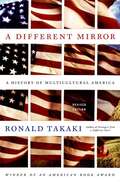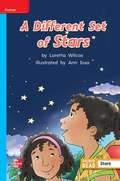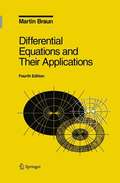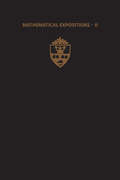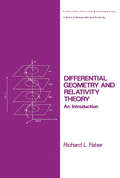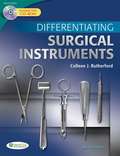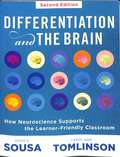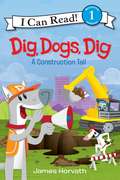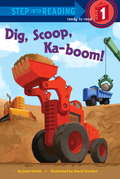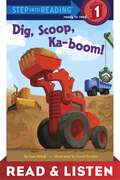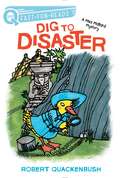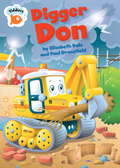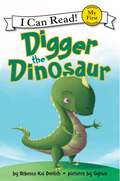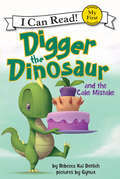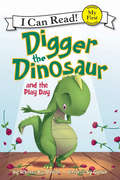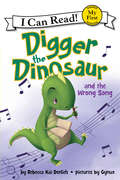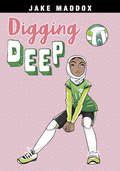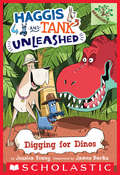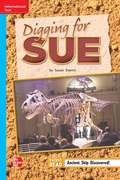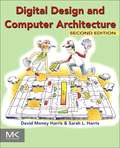- Table View
- List View
A Different Mirror: A History of Multicultural America
by Ronald TakakiTakaki (emeritus, ethnic studies, U. of California-Berkeley) takes the perspective of ethnic, racial, and national minorities to recount the history of the US since the founding of the first English colony in 1607. The first edition won an American Book Award in 1993. This second incorporates new passages on Franklin Roosevelt's response to the Holocaust, the influx of Southeast Asian immigrants after the Vietnam War, and people pushed northward by poverty in Mexico.
Differential Equations and Their Applications: An Introduction to Applied Mathematics (Fourth Edition)
by F. John Jerrold E. Marsden Martin Golubitsky W. Jager Lawrence Sirovich Martin BraunUsed in undergraduate classrooms across the USA, this is a clearly written, rigorous introduction to differential equations and their applications. Fully understandable to students who have had one year of calculus, this book distinguishes itself from other differential equations texts through its engaging application of the subject matter to interesting scenarios. This fourth edition incorporates earlier introductory material on bifurcation theory and adds a new chapter on Sturm-Liouville boundary value problems. Computer programs in C, Pascal, and Fortran are presented throughout the text to show readers how to apply differential equations towards quantitative problems.
Differential Geometry (Mathematical Expositions #no. 11)
by Erwin KreyszigThis book is intended to meet the need for a text introducing advanced students in mathematics, physics, and engineering to the field of differential geometry. It is self-contained, requiring only a knowledge of the calculus. The material is presented in a simple and understandable but rigorous manner, accompanied by many examples which illustrate the ideas, methods, and results. The use of tensors is explained in detail, not omitting little formal tricks which are useful in their applications. Though never formalistic, it provides an introduction to Riemannian geometry.<P><P> The theory of curves and surfaces in three-dimensional Euclidean space is presented in a modern way, and applied to various classes of curves and surfaces which are of practical interest in mathematics and its applications to physical, cartographical, and engineering problems. Considerable space is given to explaining and illustrating basic concepts such as curve, arc length, surface, fundamental forms; covariant and contravariant vectors; covariant, contravariant and mixed tensors, etc.<P> Interesting problems are included and complete solutions are given at the end of the book, together with a list of the more important formulae. No pains have been spared in constructing suitable figures.
Differential Geometry and Relativity Theory: An Introduction (Monographs and Textbooks in Pure and Applied Mathematics #76)
by Richard L. Faber<p>Differential Geometry and Relativity Theory: An Introduction approaches relativity asa geometric theory of space and time in which gravity is a manifestation of space-time curvature, rather than a force. Uniting differential geometry and both special and general relativity in a single source, this easy-to-understand text opens the general theory of relativity to mathematics majors having a background only in multivariable calculus and linear algebra. The book offers a broad overview of the physical foundations and mathematical details of relativity, and presents concrete physical interpretations of numerous abstract concepts in Riemannian geometry. <p>The work is profusely illustrated with diagrams aiding in the understanding of proofs and explanations. Appendices feature important material on vector analysis and hyperbolic functions. <p>Differential Geometry and Relativity Theory: An Introduction serves as the ideal text for high-level undergraduate courses in mathematics and physics, and includes a solutions manual augmenting classroom study. It is an invaluable reference for mathematicians interested in differential and Riemannian geometry, or the special and general theories of relativity.</p>
Differentiating Surgical Instruments
by Colleen RutherfordMore than 800 instruments and tips associated with official names, common nicknames, and descriptions of instrument features, categories, and uses: Common types of clamping, grasping, cutting, and retracting instruments. Instruments for specialized procedures (such as bowel, thyroid or breast surgery). Cutting loops, and the parts that make up cytoscopes and resectoscopes. Orthopedic drills and saw blades. Instruments used in microscopic and endoscopic surgery. Organization based on surgical specialties. "Surgical Sessions" provide chapter review questions and critical thinking scenarios.
Differentiation And The Brain: How Neuroscience Supports The Learner-friendly Classroom
by David A. Sousa Carol Ann TomlinsonStudents are becoming more academically and culturally diverse, making it more important than ever to shift away from a one-size-fits-all approach and toward differentiated instruction. The second edition of this best-selling book will help you create truly effective, brain-friendly classrooms for all learners. The authors share an array of updated differentiated instruction examples, scenarios, and exercises, as well as the latest educational psychology research from cognitive psychology, neuroscience, and pedagogy. Learn more about teaching diverse learners using brain-based learning strategies: Explore how the brain learns and approaches to differentiated instruction. Sharpen your knowledge of developmental cognitive neuroscience and educational psychology to teach the best content in the best possible way. Use the knowledge of educational neuroscience (neuroeducation) to benefit the students you teach. Design and implement strategies for effective differentiated instruction. Create a positive and productive learning environment that supports diversity in the classroom. A joint publication of ASCD and Solution Tree
Dig, Dogs, Dig: A Construction Tail (I Can Read Level 1)
by James HorvathBeginning readers will love this I Can Read adventure starring a doggy construction crew, gently adapted from James Horvath’s popular picture book of the same title. Top dog Duke and his crew of construction-worker dogs are hard at work building a new park. They need lots of cool equipment to help them dig, haul, push, and plow—like a backhoe, dump truck, bulldozer, and grader. But what happens when the crew finds something unexpected buried deep in the ground?Dig, Dogs, Dig is a Level One I Can Read book, which means it’s perfect for children learning to sound out words and sentences.
Dig, Scoop, Ka-boom! (Step into Reading)
by Joan Holub David GordonA construction site crew is busy at work in this rhyming Step 1 story. As the work continues readers are in for a surprise--the "crew" is actually a group of young friends engaged in a fun day of dramatic play. Two sheets of vehicle-themed stickers are included. It's a natural for young readers who love to build and are fans of vehicles that dig, scoop, and sometimes go ka-boom!
Dig, Scoop, Ka-boom! Read & Listen Edition (Step into Reading)
by Joan HolubA construction site crew is busy at work in this rhyming Step 1 story. As the work continues readers are in for a surprise--the "crew" is actually a group of young friends engaged in a fun day of dramatic play. Two sheets of vehicle-themed stickers are included. It's a natural for young readers who love to build and are fans of vehicles that dig, scoop, and sometimes go ka-boom!This ebook contains Read & Listen audio narration.
Dig to Disaster: A Miss Mallard Mystery (QUIX)
by Robert QuackenbushWorld-famous duck-tective Miss Mallard must discover who is terrorizing an archaeological expedition in this mystery that launches QUIX, a new line of fun-to-read short chapter books that are perfect for emerging readers.A terrifying headless demon threatens an archaeological expedition in the jungles of South America in this Miss Mallard Mystery. Bestselling author Robert Quackenbush’s super-sleuth, Miss Mallard, is on the case to find the true villain!
Digger Don (Tiddlers #25)
by Elizabeth DaleDigger Don is struck by lightning! Then he just can't stop digging - when will he stop The Tiddlers series features fun stories with a word count of fewer than 50 words for children who are just starting to read.A word list at the beginning of the story allows for a quick check of the reader's ability to read and understand words before reading, and a puzzle at the end of the story encourages rereading for pleasure.
Digger the Dinosaur (My First I Can Read)
by Rebecca DotlichDigger the Dinosaur may be huge, but he has the heart of a preschooler. He loves to help but gets mixed up a lot. In Digger the Dinosaur, Digger wants to play baseball with his friends. But he isn’t allowed to go out until he’s cleaned his room. Digger starts cleaning at top speed, but the faster he moves the messier his room gets. His big tail and big feet aren’t helping! Will Digger win the race to tidy his room and get to the game on time? Gynux’s full-color illustrations capture Digger’s lovable personality. Digger the Dinosaur is a My First I Can Read book. That means it’s perfect for shared reading with a child.
Digger the Dinosaur and the Cake Mistake (My First I Can Read)
by Rebecca DotlichReaders will roar with laughter as Digger the Dinosaur mixes up silly phrases in his second fully illustrated I Can Read title.Today is the big dino party! Digger and Dadasaur take a ride into town to get a cake, but before long, they get lost. Can Momasaur help Digger before it’s too late? Or will Digger and Dadasaur have to go home cakeless?Beginning readers will learn common sight words and simple phonics sounds. Digger the Dinosaur and the Cake Mistake is a My First I Can Read book, which means it’s perfect for shared reading with a child.
Digger the Dinosaur and the Play Day (My First I Can Read)
by Rebecca DotlichDigger the Dinosaur is starring in a play! But will he remember all the lines he has to say? Young children just learning to read will enjoy the warmth and humor of this My First I Can Read story about a little dinosaur who keeps trying, no matter what.Author Rebecca Kai Dotlich is a poet and picture book author of such titles as What Is Science? and Lemonade Sun (an American Booksellers "Pick of the Lists"). Her work is featured widely in poetry anthologies and textbooks. My First I Can Read books are ideal for sharing with emergent readers.
Digger the Dinosaur and the Wrong Song (My First I Can Read)
by Rebecca DotlichIt's Stego's birthday and Digger knows the perfect present to give his best friend—a song! But when Digger mixes up the words, things get super silly.Join Digger the Dinosaur in all his I Can Read adventures!
Digging Deep (Jake Maddox Girl Sports Stories)
by Jake MaddoxAsiyah Najjar is upping her volleyball game and joining the travel team. But the practices are longer, harder, and more frequent than her old rec squad's. Now easy-going Asiyah is having a tough time focusing up and making the commitment. Can she dig deep and jump to the next level of play? With a glossary, writing prompts, discussion questions, and extra volleyball info, this fast-paced Jake Maddox sports story is a win-win for both educators and students!
Digging for Dinos: A Branches Book (Haggis and Tank Unleashed #2)
by Jessica YoungMeet Haggis and Tank--two dogs with BIG imaginations!This series is part of Scholastic's early chapter book line called Branches, which is aimed at newly independent readers. With easy-to-read text, high-interest content, fast-paced plots, and illustrations on every page, these books will boost reading confidence and stamina. Branches books help readers grow!Haggis and Tank's big imaginations take them on a search for real live dinosaurs! They build a nest for dino eggs and play baseball with a triceratops. But then the ground starts shaking. Is a T-rex chasing Haggis and Tank? Or could something else be headed their way? This series is full of clever wordplay and homophones that make Haggis and Tank's adventures even more fun!
Digging for Treasure (Fountas & Pinnell Classroom, Guided Reading)
by Joan NicholsNIMAC-sourced textbook. Is It Junk, or Is It History? It's both! Every day, centuries-old rubbish washes up on the muddy shore of the River Thames in England—and every bit of it has a story to tell. Join the mudlarks of London as they unearth treasures from the past.
Digital Design and Computer Architecture
by David Harris Sarah HarrisDigital Design and Computer Architecture, Second Edition, takes a unique and modern approach to digital design, introducing the reader to the fundamentals of digital logic and then showing step by step how to build a MIPS microprocessor in both Verilog and VHDL. This new edition combines an engaging and humorous writing style with an updated and hands-on approach to digital design. It presents new content on I/O systems in the context of general purpose processors found in a PC as well as microcontrollers found almost everywhere. <p><p> Beginning with digital logic gates and progressing to the design of combinational and sequential circuits, the book uses these fundamental building blocks as the basis for the design of an actual MIPS processor. It provides practical examples of how to interface with peripherals using RS232, SPI, motor control, interrupts, wireless, and analog-to-digital conversion. SystemVerilog and VHDL are integrated throughout the text in examples illustrating the methods and techniques for CAD-based circuit design. There are also additional exercises and new examples of parallel and advanced architectures, practical I/O applications, embedded systems, and heterogeneous computing, plus a new appendix on C programming to strengthen the connection between programming and processor architecture. <p> This new edition will appeal to professional computer engineers and to students taking a course that combines digital logic and computer architecture.
Digital Graphics and Animation with Adobe® Illustrator® 10, Adobe® Photoshop® 7, and Macromedia® Flash® MX
by Prentice HallDigital Graphics and Animation includes two types of projects: free-form projects and step-by-step projects.
